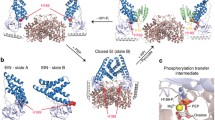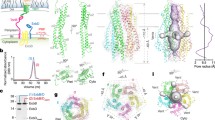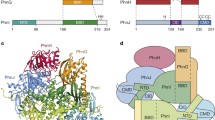Abstract
A nitrogen-related signal transduction pathway, consisting of the three phosphotransfer proteins EINtr, NPr, and IIANtr, was discovered recently to regulate the uptake of K+ in Escherichia coli. In particular, dephosphorylated IIANtr inhibits the activity of the K+ transporter TrkA. Since the phosphorylation state of IIANtr is partially determined by its reversible phosphorylation by NPr, we have determined the three-dimensional structure of NPr by solution NMR spectroscopy. In total, we obtained 973 NOE-derived distance restraints, 112 chemical shift-derived backbone angle restraints, and 35 hydrogen-bond restraints derived from temperature coefficients (wave). We propose that temperature wave is useful for identifying exposed beta-strands and assists in establishing protein folds based on chemical shifts. The deduced structure of NPr contains three α-helices and four β-strands with the three helices all packed on the same face of the β-sheet. The active site residue His16 of NPr for phosphoryl transfer was found to be neutral and in the Nε2-H tautomeric state. There appears to be increased motion in the active site region of NPr compared to HPr, a homologous protein involved in the uptake and regulation of carbohydrate utilization.






Similar content being viewed by others
Abbreviations
- NPr:
-
Nitrogen-related HPr
- HPr:
-
Histidine-containing protein
- EINtr :
-
Nitrogen-related enzyme I
- HSQC:
-
Heteronuclear single quantum coherence spectroscopy
- IIANtr :
-
Nitrogen-related enzyme IIA
- GAF:
-
cGMP-specific and –stimulated phosphodiesterases, Anabaena adenylate cyclases and Escherichia coli FhlA
- IPTG:
-
Isopropyl-β-D-thiogalactopyranoside
- NMR:
-
Nuclear magnetic resonance
- NOE:
-
Nuclear Overhauser effect
- PCR:
-
Polymerase chain reaction
- PEP:
-
Phosphoenolpyruvate
- PTS:
-
Phosphoenolpyruvate:sugar phosphotransferase system
- RCK:
-
Regulating conductance of K+
- rmsd:
-
Root mean square deviation
- SDS-PAGE:
-
Sodium dodecylsulfate-polyacrylamide gel electrophoresis
References
Anderson JW, Bhanot P, Georges F, Klevit RE, Waygood EB (1991) Involvement of the carboxy-terminal residues in the active site of the histidine-containing protein, HPr, of the phosphoenolpyruvate:sugar phosphotransferase system of Escherichia coli. Biochemistry 30:9601–9607
Bax A, Grzesiek S (1993) Methodological advances in protein NMR. Acc Chem Res 26:131–138
Baxter NJ, Williamson MP (1997) Temperature dependence of 1H chemical shifts in proteins. J Biomol NMR 9:359–369
Bellamacina CR (1996) The nicotinamide dinucleotide binding motif: a comparison of nucleotide binding proteins. FASEB J 10:1257–1269
Bordo D, van Monfort RLM, Pijning T et al (1998) The three-dimensional structure of the nitrogen regulatory protein IIANtr from Escherichia coli. J Mol Biol 279:245–255
Bossemeyer D, Borchard A, Dosch DC et al (1989) K+-transport protein TrkA of E. coli is a peripheral membrane protein that requires other trk gene products for attachment to the cytoplsmic membrane. J Biol Chem 264:16403–16410
Chou KC (2004a) Insights from modelling three-dimensional structures of the human potassium and sodium channels. J Proteome Res 3:856–861
Chou KC (2004b) Structural bioinformatics and its impact to biomedical science. Curr Med Chem 11:2105–2134
Chou JJ, Li S, Klee CB, Bax A (2001) Solution structure of Ca2+-calmodulin reveals flexible hand-like properties of its domains. Nat Struct Biol 8:990–997
Cierpicki T, Otlewski J (2001) Amide proton temperature coefficients as hydrogen bond indicators in proteins. J Biomol NMR 21:249–261
Clore GM, Gronenborn AM (1998) Determining structures of larger proteins and protein complexes. Trends Biotechnol 16:22–34
Cornilescu G, Delaglio F, Bax A (1999) Protein backbone angle restraints from searching a database for chemical shift and sequence homology. J Biomol NMR 13:289–302
Delaglio F, Grzesiek S, Vuister GW et al (1995) NMRPipe: a multidimensional spectral processing system based on UNIX pipes. J Biomol NMR 6:277–293
Epstein W (2003) The roles and regulation of potassium in bacteria. Prog Nucleic Acid Res Mol Biol 75:293–320
Garrett DS, Powers R, Gronenborn AM, Clore GM (1991) A common sense approach to peak picking in two-, three-, and four-dimensional spectra using automatic computer analysis of contour diagrams. J Magn Reson 95:214–220
Gouaux E, MacKinnon R (2005) Principles of selective ion transport in channels and pumps. Science 310:1461–1465
Hansen DF, Vallurupalli P, Lundstrom P et al (2008) Probing chemical shifts of invisible states of proteins with relaxation dispersion NMR spectroscopy: how well can we do? J Am Chem Soc 130:2734–2735
Jia Z, Quail JW, Waygood EB, Delbaere LT (1993) The 2.0 Å resolution structure of the Escherichia coli histidine-containing phosphocarrier protein HPr: a redetermination. J Biol Chem 268:22940–22501
Jiang Y, Pico A, Cadene M et al (2001) Structure of the RCK domain from the E. coli K+ channel and demonstration of its presence in human BK channel. Neuron 29:593–601
Kay LE (1997) NMR methods for the study of protein structure and dynamics. Biochem Cell Biol 75:1–15
Kay LE, Torchia DA, Bax A (1989) Backbone dynamics of proteins as studied by 15N inverse detected heteronuclear NMR spectroscopy: application to staphylococcal nuclease. Biochemistry 28:8972–8979
Klevit RE, Waygood EB (1986) Two-dimensional 1H NMR studies of histidine-containing protein from Escherichia coli. 3. Secondary and tertiary structure as determined by NMR. Biochemistry 25:7774–7781
Koradi R, Billeter M, Wüthrich K (1996) MOLMOL: a program for display and analysis of macromolecular structures. J Mol Graph 14:51–55
Kruse R, Hengstenberg W, Beneicke W, Kalbitzer HR (1993) Involvement of various amino- and carboxyl-terminal residues in the active site of the histidine-containing protein HPr of the phosphoenolpyruvate-dependent phosphotransferase system of Staphylococcus carnosus: site-directed mutagenesis with the ptsH gene, biochemical characterization and NMR studies of the mutant proteins. Protein Eng 6:417–423
Laskowski RA, MacArthur MW, Moss DS, Thornton JM (1993) PROCHECK: a program to check the stereochemical quality of protein structure. J Appl Cryst 26:283–291
LaVallie ER, DiBlasio EA, Kovacs S et al (1993) A thioredoxin gene fusion expression system that circumvents inclusion body formation in the E. coli cytoplasm. Biotechnology (NY) 11:187–193
Lee CR, Koo BM, Cho SH et al (2005) Requirement of the dephospho-form of enzyme IIANtr for derepression of Escherichia coli K-12 ilvBN expression. Mol Microbiol 58:334–44
Lee CR, Cho S-H, Yoon MJ, Peterkofsky A, Seok YJ (2007) Escherichia coli IIANtr regulates the K+ transporter TrkA. Proc Natl Acad Sci USA 104:4124–4129
Li X, Peterkofsky A, Wang G (2003) 1H, 15N, and 13C chemical shift assignments of the Escherichia coli nitrogen regulatory phosphocarrier IIANtr. J Biomol NMR 27:401–402
MacKinnon R (2003) Potassium channels. FEBS Lett 555:62–65
Marintchev A, Frueh D, Wagner G (2007) NMR methods for studying protein-protein interactions involved in translation initiation. Methods Enzymol 430:283–331
Markley JL, Bax A, Arata Y et al (1998) Recommendations for the presentation of NMR structures of proteins and nucleic acids. IUPAC-IUBMB-IUPAB Inter-Union Task Group on the Standardization of Data Bases of Protein and Nucleic Acid Structures Determined by NMR Spectroscopy. J Biomol NMR 12:1–23
Merrick MJ, Coppard JR (1989) Mutations in genes downstream of the rpoN gene (encoding σ54) of Klebsiella pneumoniae affect expression from σ54-dependent promoters. Mol Microbiol 3:1765–1775
Pelton JG, Torchia DA, Meadow ND, Roseman S (1993) Tautomeric states of the active-site histidines of phosphorylated and unphosphorylated IIIGlc, a signal-transducing protein from Escherichia coli, using two-dimensional heteronuclear NMR techniques. Protein Sci 2:543–558
Peterkofsky A, Wang G, Garrett DS et al (2001) Three-dimensional structures of protein–protein complexes in the E. coli PTS. J Mol Microbiol Biotechnol 3:347–354
Peterkofsky A, Wang G, Seok Y-J (2006) Parallel PTS systems. Arch Biochem Biophys 453:99–105
Powell BS, Court DL, Inada T et al (1995) Novel proteins of the phosphotransferase system encoded within the rpoN operon of Escherichia coli. Enzyme IIANtr affects growth on organic nitrogen and the conditional lethality of an erats mutant. J Biol Chem 270:4822–4839
Rabus R, Reizer J, Paulsen I, Saier MH Jr (1999) Enzyme INtr from Escherichia coli. A novel enzyme of the phosphoenolpyruvate-dependent phosphotransferase system exhibiting strict specificity for its phosphoryl acceptor, NPr. J Biol Chem 274:26185–26191
Reddy P, Peterkofsky A, McKenney K (1989) Hyperexpression and purification of Escherichia coli adenylate cyclase using a vector designed for expression of lethal gene products. Nucleic Acids Res 17:10473–10488
Schlosser A, Hamann A, Bossemeyer D et al (1993) NAD+ binding to the Escherichia coli K+-uptake protein TrkA and sequence similarity between TrkA and domains of a family of dehydrogenases suggest a role for NAD+ in bacterial transport. Mol Microbiol 9:533–543
Schnell JR, Chou JJ (2008) Structure and mechanism of the M2 proton channel of influenza A virus. Nature 451:591–595
Schwieters CD, Kuszewski JJ, Tjandra N, Clore GM (2003) The Xplor-NIH NMR molecular structure determination package. J Magn Reson 160:65–73
Surks HK, Mochizuki N, Kasai Y et al (1999) Regulation of myosin phosphatase by a specific interaction with cGMP-dependent protein kinase Ialpha. Science 286:1583–1587
Wang G (2008) NMR of membrane-associated peptides and proteins. Curr Protein Pept Sci 9:50–69
Wang G, Wylie GP, Twigg PD et al (1999) Solution structure and peptide binding studies of the C-terminal Src homology 3-like domain of the diphtheria toxin repressor protein. Proc Natl Acad Sci USA 96:6119–6124
Wang G, Louis JM, Sondej M et al (2000) Solution structure of the phosphoryl transfer complex between the signal transducing proteins HPr and IIAglucose of the Escherichia coli phosphoenolpyruvate:sugar phosphotransferase system. EMBO J 19:5635–5649
Wang G, Peterkofsky A, Keifer PA, Li X (2005) NMR characterization of the Escherichia coli nitrogen regulatory protein IIANtr in solution and interaction with its partner protein, NPr. Protein Sci 14:1082–1090
Wishart DS, Sykes BD (1994) The 13C chemical shift index: a simple method for the identification of protein secondary structure using 13C chemical shift data. J Biomol NMR 4:171–180
Wishart DS, Sykes BD, Richards FM (1991) Relationship between nuclear magnetic resonance chemical shift and protein secondary structure. J Mol Biol 222:311–333
Wüthrich K (1986) NMR of proteins and nucleic acids. Wiley, New York
Zhou GP, Troy FA (2005) NMR studies on how the binding complex of polyisoprenol recognition sequence peptides and polyisoprenols can modulate membrane structure. Curr Protein Pept Sci 6:399–411
Acknowledgments
This research was supported by the startup fund from the Eppley Institute of the University of Nebraska Medical Center (UNMC) to G.W. and, in part, by the Intramural Research Program of the NIH, NHLBI to A.P. The support of UNMC also includes the accessibility to the NMR Core Facility (supported by both a CORE grant from the National Cancer Institute-NIH and the Nebraska Research Initiative NRI). We are grateful to Frank Delaglio and Dan Garrett (NIH) for NMR software. We thank Paul Keifer for maintaining the NMR hardware during this study.
Author information
Authors and Affiliations
Corresponding author
Rights and permissions
About this article
Cite this article
Li, X., Peterkofsky, A. & Wang, G. Solution structure of NPr, a bacterial signal-transducing protein that controls the phosphorylation state of the potassium transporter-regulating protein IIANtr . Amino Acids 35, 531–539 (2008). https://doi.org/10.1007/s00726-008-0079-9
Received:
Accepted:
Published:
Issue Date:
DOI: https://doi.org/10.1007/s00726-008-0079-9




